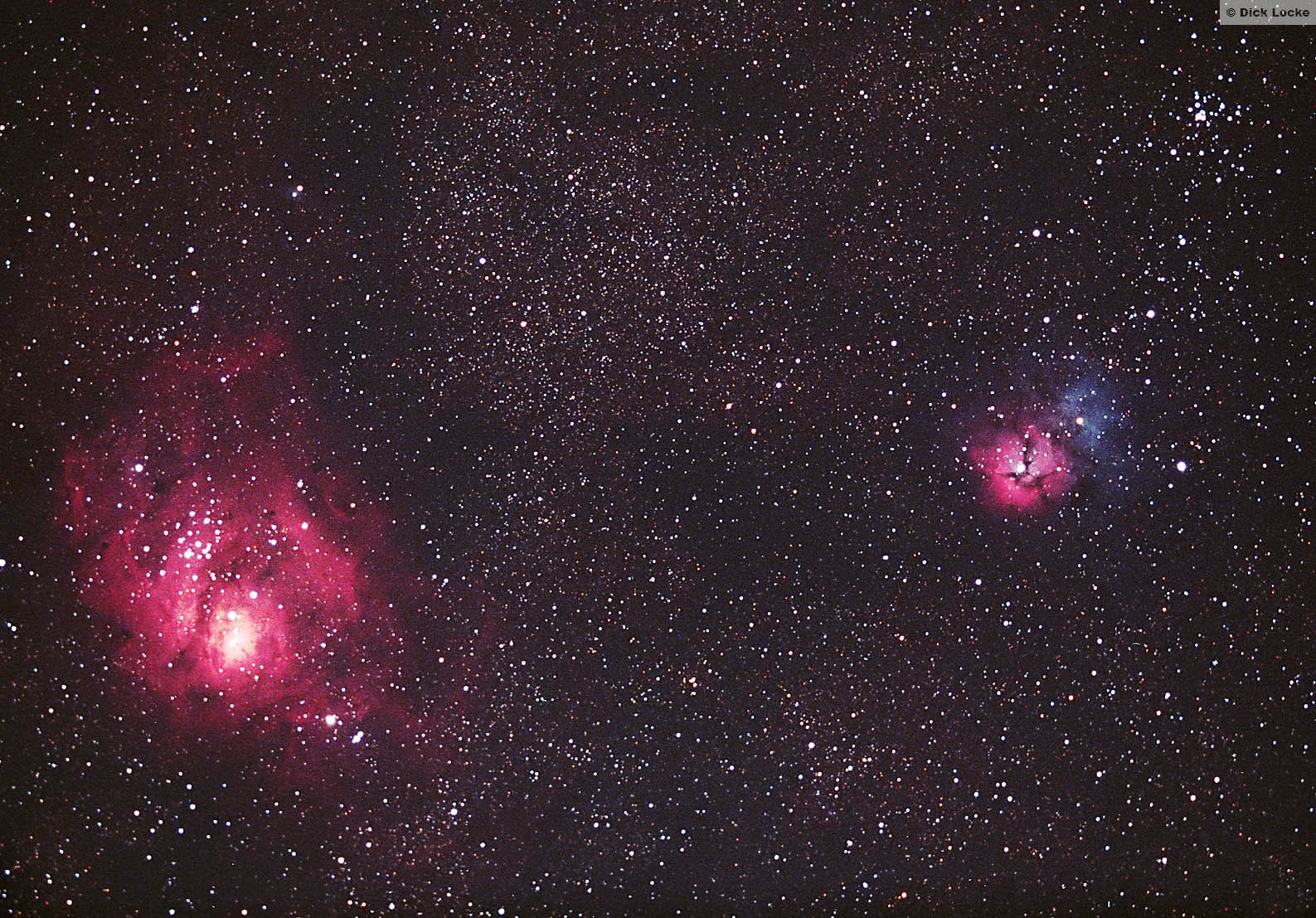
Lagoon and Trifid Nebula Wide Area Image
Trifid (M20) and Lagoon (M8) Nebulae Area Pictures
All images and text on this web site Copyright © 1998-2014 by Dick Locke. All Rights Reserved. Contact and Image Use Information
This page features images of an incredible area of the sky. Messier objects M8 and 20 (and many more) are located just above and to the right of the Sagittarius "teapot" asterism, in the middle of the southern summer milky way. M8 is a naked-eye object on a clear night from a dark sky. If you prefer, this page provides a pictorial index to some of the best objects in the area. This page presents a huge close-up of M8 featuring 14 hours total exposure.

The Lagoon Nebula (M8) is the large object upper left. The Trifid Nebula (which includes the blue reflection nebula) is M20 on the bottom left. The area to the right is NGC 6559 & various other objects that often get overlooked due to the brighter neighbors.
The above consists of 56 total exposures of 5 minutes each: 10 red, 8 green, 14 blue, and 24 H-alpha, for a total of 4.66 hrs. The images are from the SBIG ST-8300m monochrome camera, narrowband and RGB filters, and the Takahashi FSQ-85 telescope with reducer (328mm focal length) from the 2014 Davis Mountains trip. My equipment rides on the AP 900GTO mount. My processing techniques are discussed here. I blended the H-alpha into the red at about 50% on this one. This area is relatively bright, which helps make processing easier. I wrestled with some color gradients due to sky glow and the relatively low elevation of this area, as well as the overall color balance itself. This image was blended into the 14 hour Lagoon Nebula image shown on this page.

The image above is from the 2011 Spring Davis Mountains Trip. One hour total exposure through the Takahashi FSQ-85 Telescope, AP 900GTO mount, QHY8 CCD Camera. The image could benefit from a little flat-fielding but nice first results I think.
These are seen on my Star Cloud (M24) Pictures Page M8 (the bright red Lagoon nebula) is pictured on the left. To the right you can see the Trifid Nebula, M20. Above M8, looking a bit like a paw to me, are NGC6559, IC4685. Click the hyperlinks to be taken to dedicated pages featuring closer views of those objects. Other nearby objects not to be missed are open cluster M21 (visible in the image above, to the upper right of the Trifid), and M24, the little starcloud.
Above: M20 and M8 from the Davis Mountains, stack of 2 exposures ~25 minutes, Nikon 300mm f2.8 lens, Kodak LE 400 film. As I look at it in 2011 it's a bit too saturated.

Here's the "Hour Glass" or "Lagoon" nebula (M8) and the "Trifid" (M20) nebula. I don't really see the lagoon or hour glass, but this nebula (M8) is the big red one on the left. The Trifid nebula is a cool contrast of a red emission nebula on the left and a blue reflection nebula on the right. You can make out the dust lanes in the red region. Image details: 50 minute exposure, Davis Mountains, TX, April 24, 2001, STV auto guider, Losmandy GM-11 Tak FS-102 prime focus with reducer at 610mm focal length, f5.9 Kodak PJ 400 film Negative Scan, Nikon Coolscan IV ED, Processed in Photoshop. M21 is above/right of the trifid nebula.

Stack of two images using using Fuji SHQ 200 film in a Nikon F2 body. Takahashi TOA 130 Not bad for a fairly heavily loaded G-11 and a quick polar alignment! Revised version (above) posted 9/10/05. Skully points out that M21 (open cluster) is visible on the upper right.
NHAC member Jeff Winship noted:


A Visual Index to all the cool objects around M8 and M20 is here.
Astronomy Pictures: Dick Locke's Astrophoto Gateway page....
Copyright © Dick Locke. All Rights Reserved.
Contact and Image Use Information
hits since 5/27/2004 update.
Old 2004 shot:
M8/M20 Area
Above, 9/26/04: M8/M20 area, Prime focus Tak FS-102. This is pretty much the full frame; 22min exposure using focal reducer.